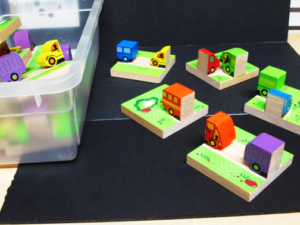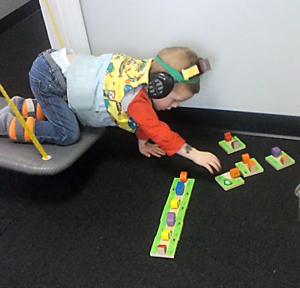
This “game” uses parts of a roadway to capture attention. Consequently, the appealing visual images subtly draw the child into a mindset of sustaining attention to the “what” and “where” ideas needed to solve the puzzle of a layout.
This game of dominoes uses cars and trucks, and presents the problem of locating the front and back of each vehicle. A clue is given in that the front of each vehicle has a “driver” . In order to “match” the cars and trucks, the child will have to match colors as well as consider both the front and the back end of each vehicle. In addition, the players will also have to consider whether or not the placement of their piece “fits in” with the layout as a whole.

Language based visual perception addresses ideas such as “what is it?” and “where is it?”. Exploration of these concepts will guide the children who play these types of games from early learning throughout much of the academic career.
Additionally, this activity is intentionally being introduced on a swing, rather than at a desktop in order to activate vestibular input. When activated for this activity, the vestibular system sends information to:
❶ The reticular activating system, signaling the body’s alert system to pay attention, and stay alert, your body is moving in space!
❷ The visual system, signaling the visual mechanisms to monitor the eyes to sustain eye gaze upon each target for comparison.
❸ The language system, signaling auditory processing structures to answer questions about what exactly is being shown with each vehicle part so that a comparison can be made.
The activity as a whole unit addresses a variety of learning goals for preschoolers through the middle of elementary school.


Comments are closed.